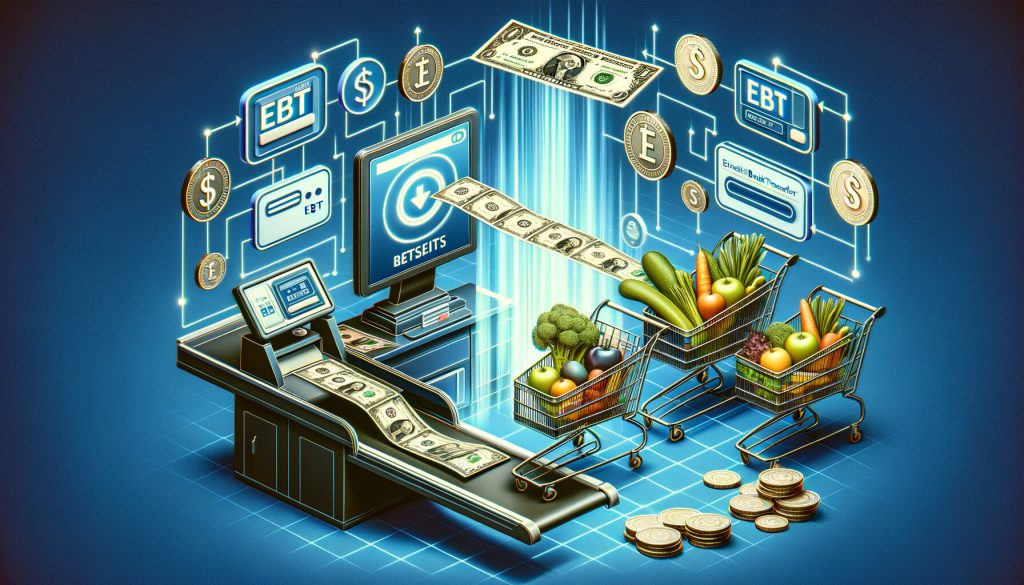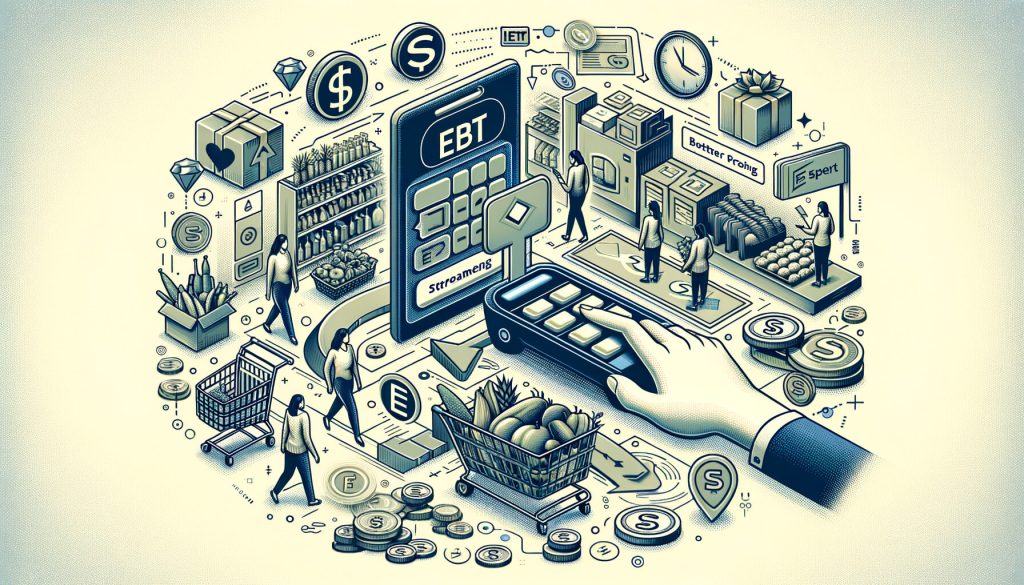
By Ethan Brooks November 2, 2024
Electronic Benefits Transfer (EBT) payment processing is a crucial component for grocery stores that accept government assistance programs such as the Supplemental Nutrition Assistance Program (SNAP). Understanding how EBT payment processing works is essential for grocery store owners and managers to ensure smooth transactions and compliance with federal regulations. At its core, EBT is a system that allows recipients of government assistance to pay for groceries using a card similar to a debit card. This card is loaded with benefits each month, which recipients can use to purchase eligible food items.
The process begins when a customer selects their groceries and proceeds to the checkout. At this point, the cashier or the self-checkout system prompts the customer to swipe their EBT card. The card reader then communicates with the EBT processing network to verify the card’s validity and check the available balance. This step is crucial as it ensures that the transaction can be completed without any issues. If the card is valid and there are sufficient funds, the transaction proceeds, and the amount is deducted from the customer’s EBT account.
To facilitate this process, grocery stores must have the appropriate point-of-sale (POS) systems that are capable of processing EBT transactions. These systems must be certified by the United States Department of Agriculture (USDA) to ensure they meet all necessary requirements. Additionally, store employees should be trained to handle EBT transactions, including understanding which items are eligible for purchase under SNAP guidelines. This knowledge is vital to prevent any unauthorized transactions and to assist customers effectively.
Moreover, grocery stores must adhere to specific regulations when processing EBT payments. For instance, they cannot charge sales tax on SNAP-eligible items, and they must ensure that these items are clearly marked. Furthermore, stores are prohibited from offering cash back on EBT transactions, as this could lead to misuse of benefits. Compliance with these regulations is monitored by the USDA, and violations can result in penalties or disqualification from accepting EBT payments.
In addition to understanding the technical and regulatory aspects of EBT payment processing, grocery stores should also be aware of the benefits it brings. Accepting EBT payments can significantly expand a store’s customer base, as it allows low-income individuals and families to shop there. This inclusivity not only boosts sales but also enhances the store’s reputation within the community as a supportive and accessible business.
To ensure a seamless EBT payment processing experience, grocery stores should regularly update their POS systems and software. This maintenance helps prevent technical issues that could disrupt transactions. Additionally, staying informed about changes in SNAP regulations and EBT processing requirements is crucial for ongoing compliance and customer satisfaction.
How EBT Payment Processing Works: Step-by-Step Guide
- Eligibility Determination: Before individuals can receive an EBT card, they must first apply and meet the eligibility criteria set by the state government. This typically includes factors such as income level, household size, and citizenship status.
- EBT Card Issuance: Once eligibility is determined, the state government issues an EBT card to the eligible individual or household. This card functions similarly to a debit card and is loaded with the approved benefit amount.
- Card Activation: The recipient must activate the EBT card by calling a toll-free number or visiting a designated website. This step ensures that the card is ready for use and can be securely linked to the recipient’s personal identification number (PIN).
- Shopping: When the recipient visits a grocery store, they can select the desired items and proceed to the checkout counter. At this point, they inform the cashier that they will be using an EBT card for payment.
- EBT Payment Processing: The cashier swipes the EBT card through a specialized card reader or enters the card information manually. The system verifies the card’s validity and available balance.
- PIN Entry: To complete the transaction, the recipient must enter their unique PIN on the card reader’s keypad. This step ensures that only the authorized cardholder can access and use the benefits.
- Transaction Approval: Once the PIN is entered, the system verifies the PIN’s accuracy and approves the transaction if the available balance is sufficient. The approved amount is deducted from the card’s balance, and a receipt is printed for the recipient.
- Purchase Restrictions: It is important to note that EBT cards can only be used to purchase approved items, such as food and non-alcoholic beverages. Certain items, such as tobacco, alcohol, and hot prepared foods, are typically restricted from EBT purchases.
- Balance Inquiry: Recipients can check their EBT card balance by calling a toll-free number, visiting a designated website, or using an ATM that supports balance inquiries. This allows them to keep track of their available benefits and plan their purchases accordingly.
- Replenishment: EBT benefits are typically replenished on a monthly basis, depending on the recipient’s eligibility and the specific government program. The recipient can continue to use their EBT card until the benefits are exhausted or the card expires.
Benefits and Challenges of EBT Payment Processing for Grocery Stores

EBT payment processing offers several benefits for grocery stores, as well as some challenges that need to be addressed. Let’s explore both aspects in detail.
Benefits
- Increased Customer Base: By accepting EBT payments, grocery stores can attract a larger customer base, including individuals and families who rely on government assistance programs. This can lead to increased sales and revenue for the store.
- Streamlined Payment Process: EBT payment processing eliminates the need for paper-based food stamps, reducing administrative burdens for both the store and the government. The electronic system allows for faster and more efficient transactions at the checkout counter.
- Guaranteed Payment: Unlike traditional payment methods, EBT payments are guaranteed by the government. This reduces the risk of payment fraud or insufficient funds, providing a level of financial security for grocery stores.
- Community Support: Accepting EBT payments demonstrates a commitment to serving the community and supporting individuals and families in need. It can enhance the store’s reputation and foster goodwill among customers.
Challenges
- Technology and Infrastructure: Grocery stores must invest in the necessary technology and infrastructure to process EBT transactions. This includes acquiring specialized card readers, training staff, and ensuring compatibility with the state’s EBT system.
- Compliance Requirements: EBT payment processing involves strict compliance requirements to ensure the security and integrity of the system. Grocery stores must adhere to government regulations, maintain accurate records, and undergo periodic audits.
- Limited Profit Margins: EBT payments are often lower than the average transaction value, which can impact the store’s profit margins. Grocery stores need to carefully manage their pricing strategies and product offerings to maintain profitability.
- Education and Training: Grocery store staff must be trained on how to handle EBT transactions, including understanding the eligibility criteria, approved items, and potential issues that may arise. Ongoing education is essential to ensure smooth and error-free payment processing.
Ensuring Security and Compliance in EBT Payment Processing

Security and compliance are paramount in EBT payment processing to protect the integrity of the system and the privacy of the recipients. Grocery stores must implement robust security measures and adhere to strict compliance requirements. Here are some key aspects to consider:
- Secure Card Readers: Grocery stores should use secure card readers that encrypt the cardholder’s information during the transaction. This helps prevent unauthorized access and protects against data breaches.
- PIN Protection: The PIN is a critical component of EBT payment processing, as it ensures that only the authorized cardholder can access the benefits. Grocery stores must educate their staff on the importance of keeping PINs confidential and implementing measures to prevent PIN theft or misuse.
- Compliance Audits: Government agencies conduct periodic audits to ensure that grocery stores are complying with EBT payment processing regulations. Stores must maintain accurate records, including transaction details, receipts, and reconciliation reports, to demonstrate compliance during audits.
- Fraud Prevention: Grocery stores should implement fraud prevention measures, such as monitoring for suspicious transactions, training staff to identify potential fraud indicators, and reporting any suspected fraudulent activity to the appropriate authorities.
The Role of Technology in EBT Payment Processing for Grocery Retailers

In the realm of grocery retail, technology plays a pivotal role in the efficient processing of Electronic Benefits Transfer (EBT) payments. As grocery stores strive to accommodate a diverse customer base, understanding the technological infrastructure behind EBT payment processing becomes essential. At the heart of this system is the integration of point-of-sale (POS) systems with EBT processing capabilities.
These systems are designed to seamlessly handle transactions, ensuring that customers using government assistance programs can purchase eligible food items with ease. The POS systems are equipped with specialized software that can differentiate between EBT-eligible and non-eligible items, thus streamlining the checkout process and minimizing errors.
Moreover, the technology involved in EBT payment processing extends beyond the POS systems. It encompasses secure data transmission protocols that protect sensitive customer information. This is crucial, as EBT transactions involve the transfer of personal and financial data that must be safeguarded against potential breaches.
Retailers employ encryption and tokenization techniques to ensure that data is transmitted securely between the store’s systems and the financial institutions responsible for processing the payments. This not only protects the customer but also instills confidence in the use of EBT cards as a reliable payment method.
In addition to security measures, technology facilitates real-time transaction processing, which is vital for both retailers and customers. When an EBT card is swiped at the checkout, the transaction is processed almost instantaneously, allowing for immediate verification of available funds and eligibility. This rapid processing is made possible through advanced networking technologies that connect the retailer’s systems with state and federal EBT databases. As a result, customers experience minimal wait times, and retailers can efficiently manage their checkout lines.
Furthermore, technology aids in compliance with government regulations. EBT payment processing systems are designed to adhere to specific guidelines set forth by the Supplemental Nutrition Assistance Program (SNAP) and other assistance programs. These systems are regularly updated to reflect changes in eligibility criteria and product restrictions, ensuring that retailers remain compliant with the latest regulations. This compliance is crucial for maintaining the integrity of the EBT program and for preventing fraudulent activities.
The role of technology in EBT payment processing also extends to reporting and analytics. Retailers can leverage data collected from EBT transactions to gain insights into purchasing patterns and customer preferences. This information can be used to optimize inventory management, tailor marketing strategies, and improve overall customer service. By analyzing transaction data, retailers can identify trends and make informed decisions that enhance their business operations.
Streamlining EBT Transactions: Best Practices for Grocery Store Owners

Streamlining EBT transactions in grocery stores is crucial for ensuring a seamless shopping experience for customers who rely on the Supplemental Nutrition Assistance Program (SNAP). As grocery store owners, understanding the intricacies of Electronic Benefits Transfer (EBT) payment processing can significantly enhance operational efficiency and customer satisfaction. To begin with, it is essential to recognize that EBT cards function similarly to debit cards, allowing recipients to purchase eligible food items. However, the process involves specific protocols and systems that must be adhered to for successful transactions.
One of the best practices for streamlining EBT transactions is investing in reliable point-of-sale (POS) systems that are compatible with EBT cards. These systems should be capable of distinguishing between eligible and non-eligible items, ensuring that only approved products are purchased using SNAP benefits. By integrating advanced POS technology, grocery store owners can minimize errors and reduce transaction times, thereby enhancing the overall shopping experience for EBT cardholders.
Moreover, training staff to handle EBT transactions efficiently is paramount. Employees should be well-versed in the nuances of EBT processing, including understanding which items are eligible for purchase and how to troubleshoot common issues that may arise during transactions. Regular training sessions can help staff stay updated on any changes in SNAP regulations and improve their ability to assist customers effectively.
In addition to staff training, clear communication with customers is vital. Store owners should ensure that signage is prominently displayed, indicating which items are eligible for purchase with EBT cards. This not only aids customers in making informed decisions but also expedites the checkout process. Furthermore, providing informational brochures or digital resources about EBT usage can empower customers to navigate their shopping experience with confidence.
Another key aspect of streamlining EBT transactions is maintaining compliance with federal and state regulations. Grocery store owners must ensure that their operations align with the guidelines set forth by the United States Department of Agriculture (USDA) and other relevant authorities. This includes regular audits and updates to POS systems to accommodate any changes in SNAP policies. By staying compliant, store owners can avoid potential penalties and maintain their eligibility to accept EBT payments.
Additionally, leveraging technology to monitor and analyze EBT transactions can provide valuable insights into customer behavior and preferences. By analyzing transaction data, store owners can identify trends and adjust inventory accordingly, ensuring that popular SNAP-eligible items are always in stock. This proactive approach not only enhances customer satisfaction but also boosts sales and profitability.
Furthermore, fostering partnerships with local organizations and government agencies can be beneficial. Collaborating with these entities can provide grocery store owners with access to resources and support, helping them better serve their EBT customers. These partnerships can also facilitate community outreach initiatives, promoting awareness about SNAP benefits and encouraging more individuals to utilize their EBT cards effectively.
Frequently Asked Questions
Q.1: How Do Grocery Stores Become Authorized to Accept EBT?
Answer: Grocery stores must apply for SNAP retailer authorization through the USDA’s Food and Nutrition Service (FNS). The application process includes meeting eligibility criteria, such as stocking staple foods across specific categories.
Q.2: What Items Can Customers Buy with EBT at Grocery Stores?
Answer: Customers can use EBT to purchase eligible food items, such as fruits, vegetables, bread, meat, dairy products, and seeds for growing food. Non-food items and prepared hot foods are not eligible for purchase with EBT.
Q.3: Are There Additional Costs for Stores to Process EBT Payments?
Answer: While there may be initial costs associated with setting up EBT-compatible POS equipment, EBT transactions typically incur lower processing fees compared to credit and debit card transactions, which can help reduce payment processing costs in the long run.
Q.4: How Can Grocery Stores Train Staff for EBT Transactions?
Answer: Grocery stores can conduct regular training sessions to educate staff on EBT rules, eligible items, and transaction procedures. Providing quick-reference guides and ongoing support ensures staff remain informed and confident in processing EBT payments accurately.
Q.5: What Happens During a USDA EBT Audit?
Answer: The USDA conducts audits to ensure stores comply with SNAP requirements, reviewing transaction records and store policies on eligible items. Maintaining accurate records and adhering to EBT guidelines helps stores pass these audits smoothly.
Q.6: How Often Are EBT Benefits Distributed to SNAP Recipients?
Answer: SNAP benefits are typically distributed monthly, with the exact date depending on the state and the recipient’s case number. This consistent distribution helps grocery stores anticipate a steady flow of EBT transactions.
Q.7: Can EBT Cards Be Used Outside of Grocery Stores?
Answer: EBT cards are generally accepted at authorized retailers like grocery stores, farmers’ markets, and certain convenience stores. However, only stores approved by the USDA for SNAP participation can accept EBT for eligible food purchases.
Conclusion
EBT payment processing has revolutionized the way individuals and families access government assistance for purchasing groceries and essential items. Grocery stores play a crucial role in accepting EBT payments and ensuring a smooth and secure transaction process.
By understanding the step-by-step guide, benefits, challenges, and security measures involved in EBT payment processing, grocery stores can effectively serve their community and support those in need. It is essential for grocery stores to stay updated on the latest regulations and compliance requirements to maintain the integrity of the EBT system and provide a seamless experience for EBT recipients.